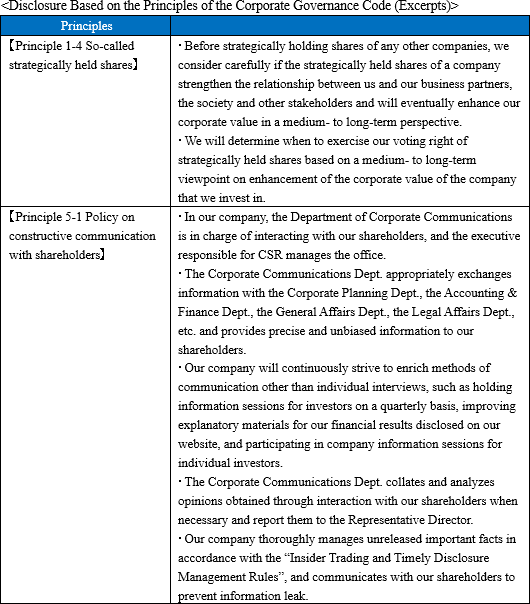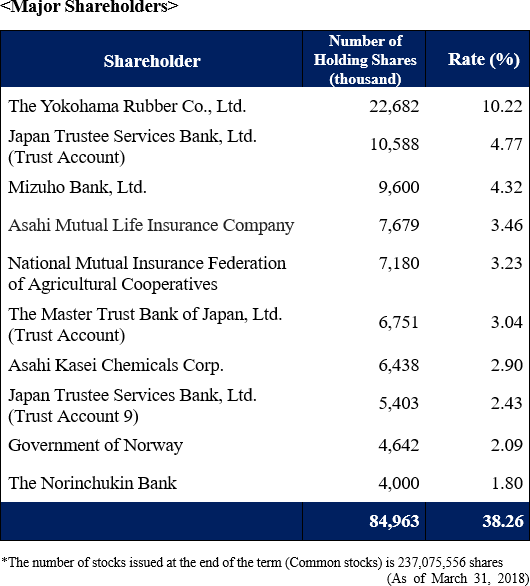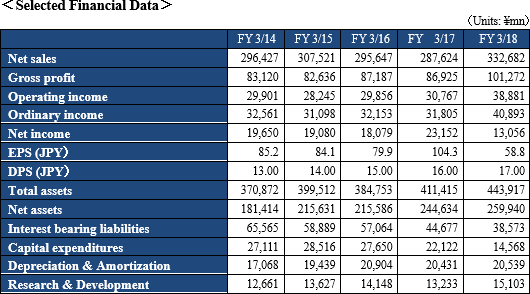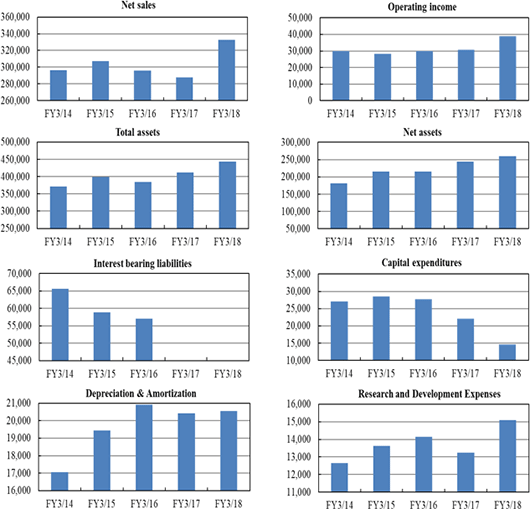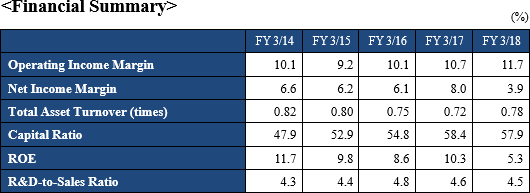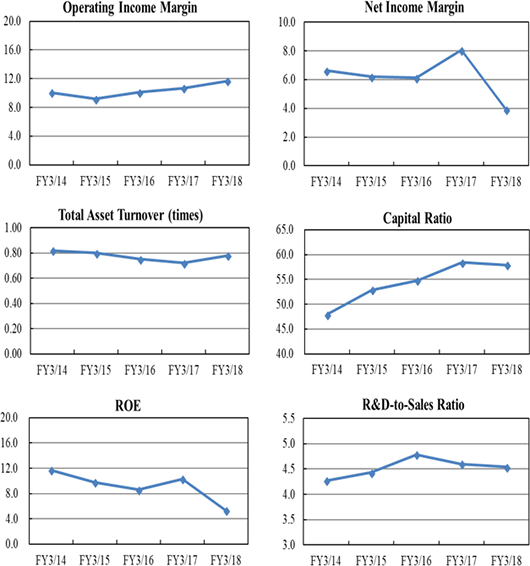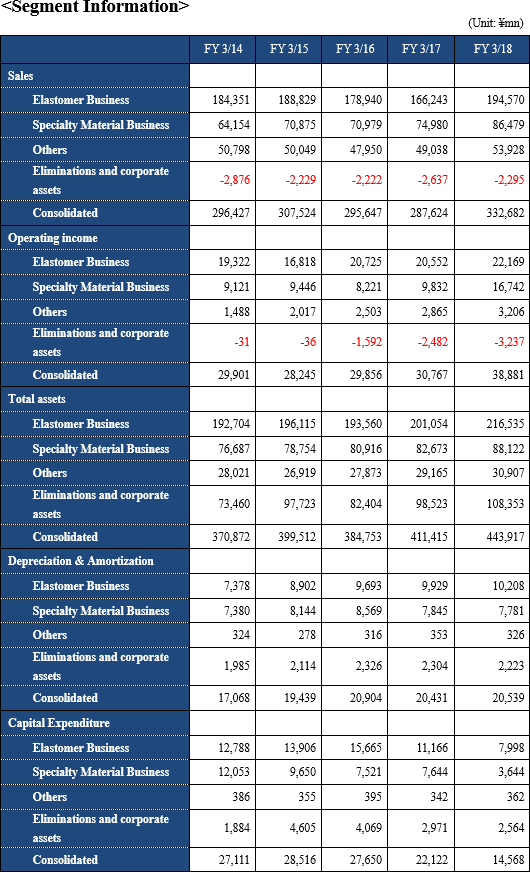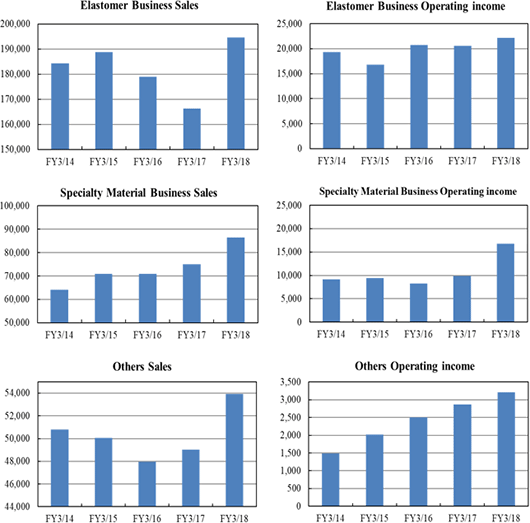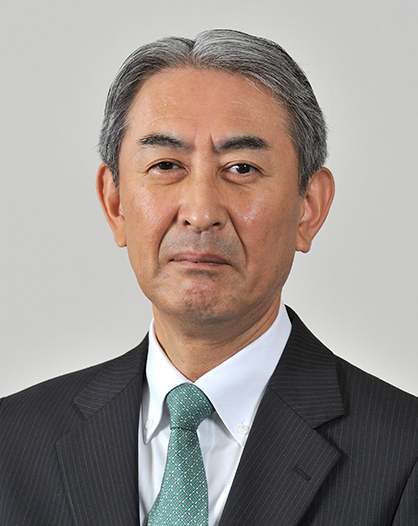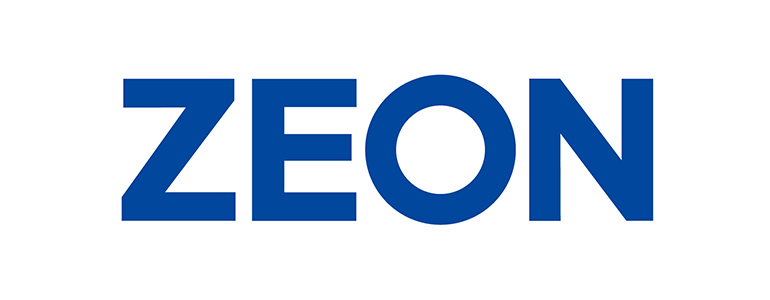ZEON CORPORATION is a petrochemical manufacturer that maintains numerous products with a large share of the global markets including synthetic rubber used in automobile parts and tires, synthetic latex used in surgery-use gloves, and other products. The Company's strengths include its creative technology development function, R&D structure, and high earnings generation capability. Many of the products and materials manufactured by Zeon are used in a wide variety of products including automobile parts and tires, rubber gloves, disposable diapers, cell phones, LCD televisions, perfumes and other products commonly used in everyday life. The Zeon Group is comprised of the parent company, 61 subsidiaries and 8 affiliated companies. Zeon also has manufacturing and marketing facilities in 16 countries around the world.
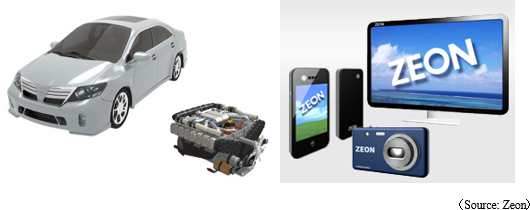 (Company Name and Management Vision)
(Company Name and Management Vision)
The company name "Zeon" is derived from the Greek word for earth "geo" (phonetically pronounced "zeo" in Japanese) and the English word reflecting eternity "eon," and reflects the Company's principle of
"deriving raw materials from the earth and perpetually contributing to human prosperity" through the development and application of creative technologies. (Zeon's original name "Geon," used at the time of its establishment, was derived from the trademark acquired for the vinyl chloride resin "Geon" from the Goodrich Corporation (then called B.F. Goodrich Company) in the United States, with which it had capital and collaborative technological agreements. The company name was changed to "Zeon" when the capital agreement was dissolved in 1970.)
(Corporate History)
Zeon was established as a joint venture company formed by the Furukawa Group of companies: Nippon Light Metal Co., Ltd., Furukawa Electric Co., Ltd., and Yokohama Rubber Co., Ltd. in April 1950 to acquire and use the vinyl chloride resin technology from B.F. Goodrich Chemicals Co.
In 1951, Goodrich acquired 35% of the shares of Zeon for full-scale technological and capital partnership, and in 1952 mass production of vinyl chloride resin began in Japan for the first time.
In 1959, Goodrich transferred synthetic rubber manufacturing technologies to Zeon, which, in turn, started Japan's first mass production of synthetic rubber. Manufacturing facilities were also expanded to match the growing demand for tires and other automobile parts.
In 1965, use of the Company's unique technology called Geon Process of Butadiene (GPB) for the efficient manufacture of butadiene (main raw material of synthetic rubber) from C4 fraction was operational.
Goodrich transferred its specialty synthetic rubber business to Zeon along with the shift in its main business focus toward vinyl chloride resins. Capital ties were dissolved in 1970. Along with these changes, the Company name was changed from Geon to Zeon in 1971.
Also in 1971, Zeon developed a unique technology called Geon Process of Isoprene (GPI) and began using it to manufacture raw materials including high-purity isoprene, hydrocarbon resins, and synthetic perfume ingredients from C5 fraction.
After entering the 1980s, Zeon aggressively launched new businesses in various fields including photoresists and other information materials, and medical-related applications in addition to its main synthetic rubber business.
In 1984, production of hydrogenated nitrile rubber Zetpol
®, which currently has top share of the worldwide market, began at the Takaoka Plant.
In 1990, manufacture of synthetic cyclo olefin polymer (COP) ZEONEX
®, which is the main product of the specialty material business using the GPI method to extract and synthesize products, was started at the Mizushima Plant.
In 1993, Zeon entered China with its electronics materials business.
In 1999, Zeon Chemicals L.P. (Consolidated subsidiary in the United States) acquired the specialty rubber business of Goodyear Tire & Rubber Company of the United States to become the world's top manufacturer of specialty rubber.
In 2000, Zeon discontinued production of vinyl chloride resins at the Mizushima Plant, and thus withdrew from the Company's founding business.
Since the 21st century came, the company has been operating business actively. For example, by releasing ZeonorFilm
®, an optical film for LCD, strengthening global production and sales systems, starting the commercial operation of styrene-butadiene rubber (S-SBR) in Singapore, upgrading the equipment for optical films for LCD in Himi-shi, Toyama Prefecture, starting the operation of the world's first mass-production factory for super-growth carbon nanotubes, and establishing a joint venture for manufacturing and selling S-SBR in cooperation with Sumitomo Chemical.
(Business Description)
Zeon's main products use various extracted from naphtha, which is extracted by distillation of crude oil.
Zeon uses butadiene extracted in the GPB method developed in-house from C4 fraction after extracting propylene (C3), isoprene monomer (IPM) extracted from C5 fraction using the GPI method, high-boil monomer (HB), dicyclopentadiene (DCPD), and 2-butyne as raw materials to be processed into synthetic rubber, synthetic latex and various other materials.
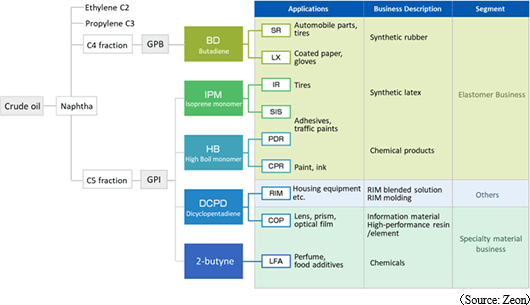
Zeon has three business segments: 1) the
elastomer business, where manufactured basic materials are sold to customers; 2) the
specialty material business, where basic materials are submitted to primary processing for sale to customers as processed materials, and 3) the
other business.
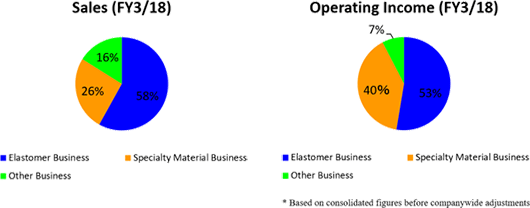 <Elastomer Business>
<Elastomer Business>
Elastomers are "high molecular compounds that have rubber-like elastic properties," an example of which is synthetic rubber. As described in the corporate history section of this report, in 1959 Zeon became the first company in Japan to mass-produce synthetic rubber, which became the foundation underlying all of Zeon's businesses. This business includes the segments of synthetic rubber, synthetic latex, and chemical products (hydrocarbon resins, thermoplastic resins) businesses.
① Synthetic Rubber Business
<Example of final product: Tires>
Zeon provides the world's leading tire manufacturers with the world's highest-quality synthetic rubber for use in tires. Among the various types of synthetic rubber manufactured are styrene butadiene rubber (SBR), which promotes superior abrasion resistance, aging resistance and mechanical strength properties, butadiene rubber (BR), which includes a superior balance between elasticity, wear and low-temperature properties, and isoprene rubber (IR), which features similar high levels of quality, consistency and other properties as natural rubber.
Zeon expects the demand for S-SBR for low fuel consumption tires, which further improved the characteristics of SBR, to expand rapidly in the future. In order to increase the supply capacity corresponding to this, Singapore plant started operation in September 2013 (the first line). The second line started operation in April 2016. The supply capacity of the Singapore plant is 70,000 tons.
<Example of product: Automobile Parts>
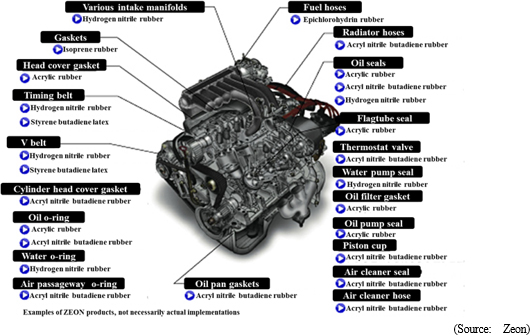
Radiator hoses, fuel hoses, fan belts, oil seals, and various other car engine parts use specialty synthetic rubber that has superior oil resistance and heat deterioration-resistant qualities. Zeon is the world's number one manufacturer of specialty synthetic rubber and features high quality levels and high market share of specialty synthetic rubber automobile parts. In particular, Zeon's Zetpol
® hydrogenated nitrile rubber, used for timing belts, displays superior heat and oil resistance and claims more than half share of the worldwide market.
Furthermore, a new grade of Zetpol
® has vastly improved the performance of products using the original versions of Zetpol
®.
Products using the new grade of Zetpol
® are heat resistant at temperatures that exceed the limits for the original version of Zetpol
® by 10 degrees centigrade, thereby extending the life of seals and gaskets, and are in strong demand for use in next generation bio-fuel engines. The new grade of Zetpol
® is well suited to extrusion processing which is being leveraged to expand its usage in various hoses. Products using Zetpol
® have also been well received by customers, and are being used increasingly as a replacement material for more expensive competitive rubber in Japan, Asia, Europe and North America.
Commercial production of the new Zetpol
® started in November 2012 at Zeon's Kawasaki Plant and reached full-scale production in 2013.
② Synthetic Latex Business
Synthetic latex is liquid rubber that synthetic rubber dispersed in water. It is used to manufacture gloves, paper coating, textile processing, adhesives, paints, and cosmetic puffs, etc. Zeon has close to 90% share of NBR latex used in cosmetic puffs.
③ Chemical Products Business
Zeon produces C5 fraction by its unique in-house GPI method, and turn it into materials for adhesive tapes and hot melt adhesive traffic paint binder and a wide variety of other products.
<Specialty Material Business>
① Specialty Plastics and Electronic Materials
Zeon deals in high value added materials and parts that are created using its unique technologies including polymer design and processing technologies.
Cyclo olefin polymer is thermoplastic polymer developed using raw material extracted from C5 fraction using GPI methods and synthesized with Zeon's own unique technologies. The commercial products are ZEONEX
® and ZEONOR
®.
ZEONEX
® leverages its high transparency, low water absorption and low absorptive properties for use in camera and projector lenses and other optical applications, and in medical use containers including syringes and vials.
ZEONOR
® leverages its high transparency, transferability, and heat resistance properties for use as transparent general use engineering plastics used in light guide plates, automobile parts, containers and a wide range of other product applications.
ZeonorFilm
® is the world's first optical film by the melt extrusion method from the cyclo olefin polymer. It is excellent in optical properties, low water absorption / low moisture permeability, high heat resistance, low outgassing and dimensional stability. Not only for displays for LCD TV, smartphones and tablets, is it expected to be used in a wide range of applications such as OLED displays.
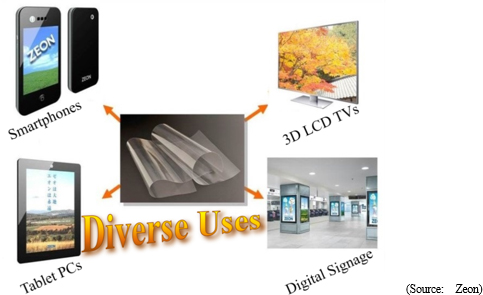
"Diagonally-stretched optical film" is also Zeon's world first development.
The OELD application as anti-reflection film is progressing, and demand for small- to medium-sized flat panel display applications is growing. In addition to the current plants in Takaoka and Himi (an annual output of 15 million square meters for optical film in total), the construction of a new plant in Tsuruga, Fukui Prefecture was completed in October 2013.
ZEOCOAT
® is organic insulation material used in electronic devices such as cellphones, smartphones, and LCD televisions. ZEOCOAT
® was successful in improving both the picture quality and reliability of displays because of its high transparency, extremely low water absorption and low gas generation properties. Zeon will aggressively expand its marketing efforts for OELDs, which will be thinner displays than LCD, thin-film transistors using new semiconductors, and flexible displays.
② Battery Materials
Zeon provides materials for lithium ion battery in this segment; anode / cathode binders, binder for functional layer (heat resistant separator), and sealant.
Currently, Li-ion batteries are widely used as a power source for mobile devices such as mobile phones and notebook computers. Due to the rapid popularization of smartphones, there is a strong demand for higher capacity batteries. Adoption for electric vehicles, including hybrid and plug-in hybrid cars, and industrial power sources (such as smart grids, etc.) also have begun, since it is lightweight, compact and can store a lot of energy. On the other hand, there was a problem that lifetime tends to decrease under high temperature usage.
The company has advanced the function of Li-ion battery binder and succeeded to develop an aqueous cathode binder, which greatly contributes to longer battery life. In addition, Zeon succeeded in commercializing anode binder, which can raise the storage capacity of Li-ion battery by 5% to 15%.
Zeon believes that its materials contribute to safety, long life and battery capacity increase of Li-ion batteries and contribute to the widespread of hybrid and electric cars.
The company focused on the promising future of Li-ion batteries and worked on it for a long time. In this business segment for 2020, Zeon seeks to keep its top share in the Li-ion battery binder market, aims to expand the diffusion of new material functions that meet the needs of the application and propose functional materials to realize the next generation of new batteries.
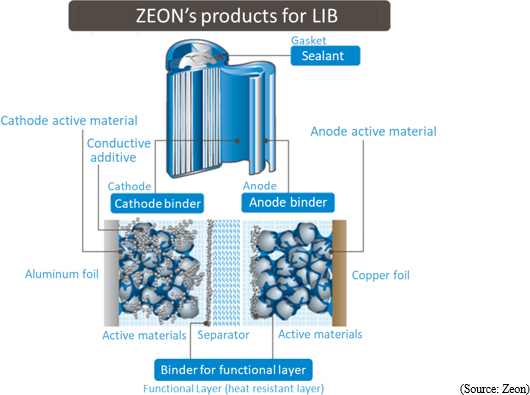 ③ Medical Device
③ Medical Device
The medical device market is relatively well insulated from fluctuations in the economy, and is anticipated to grow with the aging society in Japan and expansion in developing countries. Furthermore, medical device companies are subject to strict laws and regulations, and they need to submit approval applications to regulatory bodies. In addition, the need to develop relationships with healthcare professionals is critical and the subsequent high barriers to entry makes this a highly attractive market.
Along with the start of development of artificial kidneys in 1974, Zeon aggressively promoted its medical device business. In 1989, a subsidiary Zeon Medical Inc. was established to conduct development, manufacturing, sales and all other functions of the medical field for the Zeon Group. Zeon has shown bountiful development track record both in gastroenterology and cardiovascular area. The Offset Balloon Catheter as a means of differentiation in the gallstone removal process and with Japan's first biliary covered stent Zeostent Covered in the area of gastroenterology products, and the world's smallest diameter XEMEX IABP Balloon PLUS as a device to aid the heartbeat at times of acute myocardial infarction in the area of cardiovascular products.
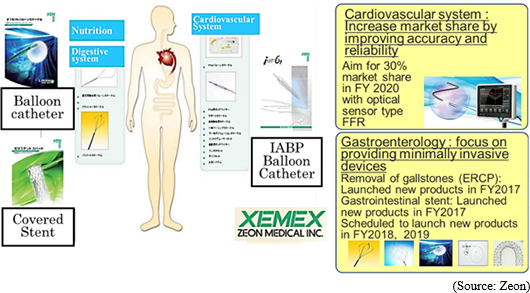
Currently Zeon is focusing efforts in the development of the gallstone removal devices that eliminate pain. Zeon has a lineup of products that can remove gallstones ranging from extremely large stones to sludge and sand with products such as XEMEX Crusher Catheter, XEMEX Basket Catheter NT, Extraction Balloon Catheter, and is aiming at a 50% share of the gallstone removal market.
In March 2016, the Company launched the world's first optical sensor FFR device as a type of guide wire. Because it uses an optical fiber sensor, mistaken readings of blood pressure measurements rarely occur. The operability as a guide wire has also gained a high evaluation and Zeon is aiming for a 30% share of the Japanese market by 2020.
④ Specialty Chemical Business
Zeon deals in specialty chemicals that use derivatives from C5 fraction, such as synthesized fragrances for cosmetics and flavor used in foods, solvents and plant growth regulator. The Company holds the world's top share of the synthesized fragrances in green note. They provide a wide range of specialty products including ingredients for intermediary bodies used in medical and agricultural chemicals, alternative CFCs solvents, cleaning agents, urethane expanding agent, and functional ether agents.
【New Specialty Materials Development: ~Carbon Nano Tube (CNT)~】
Aggressive R&D activities have allowed Zeon to launch various new materials into the market, and particularly high expectation is in the development of "single-wall carbon nanotubes (CNT)".
① What is Single-Walled CNT?
Carbon Nanotubes (CNTs) are cylindrical nanostructure formed by hexagonal lattice of carbon atoms. In 1993, Sumio Iijima, Ph.D., head of the Applied Nanotube Research Center of the National Institute of Advanced Industrial Science and Technology (AIST), discovered this structure for the first time in the world and named Carbon Nanotubes (CNTs). CNTs are categorized into single-walled and multiple-walled CNTs. Multiple-walled CNT is relatively easy to manufacture and the developments for commercial applications already started.
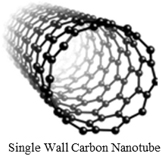
At the same time, single-walled CNT exhibits the following properties and is superior to multiple-walled CNT:
- 20 times stronger than steel
- 10 times more heat conductive than copper
- Half as dense as aluminum
- 10 times the electron mobility of silicon
- lightweight but highly flexible
- has extremely high electric-and heat-conductivity properties
Possible CNT applications are electrical conductivity assistance agent in Li-ion batteries, transparent conductive film used in electronic paper and ultra-thin touch panel because of its high elasticity and strength, and as a thermal interface material. Because of its ability to absorb a wide spectrum of light, practical applications of single-walled CNT are being promoted in the area of electromagnetic wave absorbing materials for use in a wide range of fields including energy, electronics, structural materials, and other specialty materials.
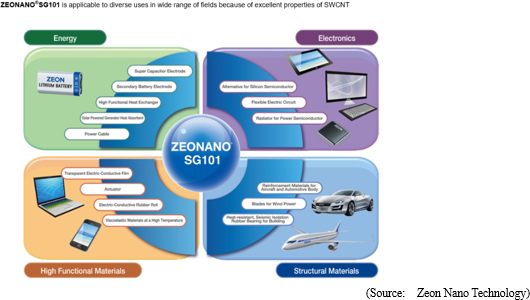
Conventional single-walled CNT has several major issues including high levels of impurities, low levels of productivity and high manufacturing costs, which are about several tens of thousands to hundreds of thousands of yen per gram.
② Zeon's Efforts and Position
Against this backdrop, the company aims at establishing technologies that are necessary for the commercialization of new products using single-walled CNT developed in Japan with its numerous superior qualities in response to the worldwide social demands to realize a low-carbon society.
Using the synthesizing technology super growth method developed by Dr. Kenji Hata (Ph.D.) of the AIST as a base, Zeon has been conducting R&D for mass production and application development for compound materials at a validation plant that was established in December 2010 on the premises of the Tsukuba Center of the AIST. Among the main reasons that the AIST Nanotube Application Research Center selected Zeon to become its partner were the impressive track record and results obtained by Kohei Arakawa, Zeon's former Managing Director, as a personnel in CNT R&D. The company is very important to realize commercial applications of this new material.
③ Future Endeavors
Having established the mass production technology based on the super growth method, Zeon completed the CNT production facility and started mass production, the first in the world in November 2015 in its Tokuyama plant at Shunan-city, Yamaguchi Prefecture.
Zeon is the only company in the world that has established mass production technologies for single-wall CNT. About 100 companies around the world request for its product samples. Consequently, shipments of samples have already begun. Zeon has also begun to propose practical applications of this product.
At the same time, single-wall CNT is a type of nanomaterial that is extremely small and fiber shape. Therefore, there is a concern that it may have some impact upon biological processes depending upon its size and shape. Currently, the AIST is conducting standardization of the evaluation process, and activities for the OECD endpoint measurement are being conducted, with global standardization and legal and regulatory aspects being considered.
<Other Business>
The combination liquid for Reaction Injection Molding (RIM) using the ingredient dicyclopentadiene (DCPD) as a raw material.
(Characteristics and Strengths)
1. World's Leading Creative Technology Development Capability
The GPB method used to manufacture butadiene from C4 fraction is the most important development in Japan's postwar history of chemicals, and is licensed to 49 plants in 19 countries around the world.
In addition, the Mizushima Plant is the world's only plant with GPI method to extract high-purity isoprene and other effective substances from C5 fraction. This Zeon's GPI method is a completely unique technology, which is not provided to other companies. Zeon is able to acquire basic ingredients used in synthesized fragrances and petroleum resin.
These two technologies represent the creative technological capabilities that are among the strengths of Zeon. They also are highly regarded and have received numerous awards in the global markets. With regard to technologies, Zeon has received 48 awards since 1960 including the GPB and GPI methods, in addition to 26 awards since 1982 for its environment conservation and safety efforts.
2. High Worldwide Share
Zetpol
®, ZEONEX
®, and ZEONOR
® are representative of the products born from Zeon's highly creative technologies, which have allowed it to acquire high shares of worldwide markets. In addition, their Leaf alcohol for in cosmetics and food flavorings and NBR latex for cosmetic puffs have the world's top share.
3. R&D Structure that Continues to Yield Creative Technologies
Zeon seeks to conduct R&D activities based upon its basic corporate philosophy of "developing creative technologies in special fields of strength that enables Zeon to contribute to society by generating the world's leading businesses."
The Company's main R&D center is located in Kawasaki City, Kanagawa Prefecture. Zeon has also established the Precision Optics Laboratory and Medical Laboratory at the Takaoka Plant, the Chemical Product Research Facility at the Yonezawa Plant and at the Mizushima Plant and the Toner Research Facility at the Tokuyama Plant for more efficient R&D activities to be conducted closer to the manufacturing sites. The technical support bases are in the U.S., Europe, Singapore, and China.
The R&D personnel are never satisfied with the current conditions, and always keep conscious of the threat that their competitors pose in their research activities. Furthermore, Zeon bases its valuation on a positive point awarding system that places high priority on speed and creativity. R&D expenses were formerly measured as a percentage of sales, but now it has established an annual value amount of ¥15.0 ~ ¥16.0 billion as an investment budget to ensure that stable R&D activities can be maintained in the future.
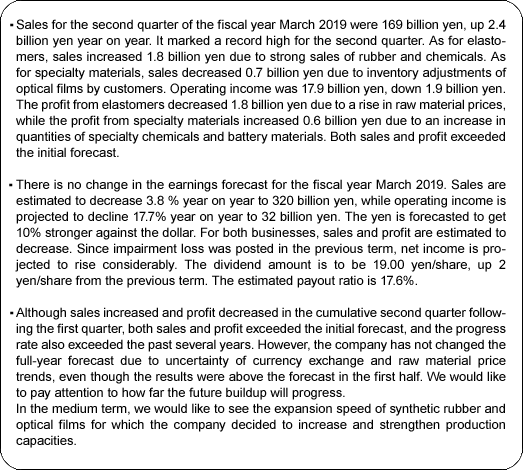
 (Company Name and Management Vision)
The company name "Zeon" is derived from the Greek word for earth "geo" (phonetically pronounced "zeo" in Japanese) and the English word reflecting eternity "eon," and reflects the Company's principle of "deriving raw materials from the earth and perpetually contributing to human prosperity" through the development and application of creative technologies. (Zeon's original name "Geon," used at the time of its establishment, was derived from the trademark acquired for the vinyl chloride resin "Geon" from the Goodrich Corporation (then called B.F. Goodrich Company) in the United States, with which it had capital and collaborative technological agreements. The company name was changed to "Zeon" when the capital agreement was dissolved in 1970.)
(Corporate History)
Zeon was established as a joint venture company formed by the Furukawa Group of companies: Nippon Light Metal Co., Ltd., Furukawa Electric Co., Ltd., and Yokohama Rubber Co., Ltd. in April 1950 to acquire and use the vinyl chloride resin technology from B.F. Goodrich Chemicals Co.
In 1951, Goodrich acquired 35% of the shares of Zeon for full-scale technological and capital partnership, and in 1952 mass production of vinyl chloride resin began in Japan for the first time.
In 1959, Goodrich transferred synthetic rubber manufacturing technologies to Zeon, which, in turn, started Japan's first mass production of synthetic rubber. Manufacturing facilities were also expanded to match the growing demand for tires and other automobile parts.
In 1965, use of the Company's unique technology called Geon Process of Butadiene (GPB) for the efficient manufacture of butadiene (main raw material of synthetic rubber) from C4 fraction was operational.
Goodrich transferred its specialty synthetic rubber business to Zeon along with the shift in its main business focus toward vinyl chloride resins. Capital ties were dissolved in 1970. Along with these changes, the Company name was changed from Geon to Zeon in 1971.
Also in 1971, Zeon developed a unique technology called Geon Process of Isoprene (GPI) and began using it to manufacture raw materials including high-purity isoprene, hydrocarbon resins, and synthetic perfume ingredients from C5 fraction.
After entering the 1980s, Zeon aggressively launched new businesses in various fields including photoresists and other information materials, and medical-related applications in addition to its main synthetic rubber business.
In 1984, production of hydrogenated nitrile rubber Zetpol®, which currently has top share of the worldwide market, began at the Takaoka Plant.
In 1990, manufacture of synthetic cyclo olefin polymer (COP) ZEONEX®, which is the main product of the specialty material business using the GPI method to extract and synthesize products, was started at the Mizushima Plant.
In 1993, Zeon entered China with its electronics materials business.
In 1999, Zeon Chemicals L.P. (Consolidated subsidiary in the United States) acquired the specialty rubber business of Goodyear Tire & Rubber Company of the United States to become the world's top manufacturer of specialty rubber.
In 2000, Zeon discontinued production of vinyl chloride resins at the Mizushima Plant, and thus withdrew from the Company's founding business.
Since the 21st century came, the company has been operating business actively. For example, by releasing ZeonorFilm®, an optical film for LCD, strengthening global production and sales systems, starting the commercial operation of styrene-butadiene rubber (S-SBR) in Singapore, upgrading the equipment for optical films for LCD in Himi-shi, Toyama Prefecture, starting the operation of the world's first mass-production factory for super-growth carbon nanotubes, and establishing a joint venture for manufacturing and selling S-SBR in cooperation with Sumitomo Chemical.
(Business Description)
Zeon's main products use various extracted from naphtha, which is extracted by distillation of crude oil.
Zeon uses butadiene extracted in the GPB method developed in-house from C4 fraction after extracting propylene (C3), isoprene monomer (IPM) extracted from C5 fraction using the GPI method, high-boil monomer (HB), dicyclopentadiene (DCPD), and 2-butyne as raw materials to be processed into synthetic rubber, synthetic latex and various other materials.
(Company Name and Management Vision)
The company name "Zeon" is derived from the Greek word for earth "geo" (phonetically pronounced "zeo" in Japanese) and the English word reflecting eternity "eon," and reflects the Company's principle of "deriving raw materials from the earth and perpetually contributing to human prosperity" through the development and application of creative technologies. (Zeon's original name "Geon," used at the time of its establishment, was derived from the trademark acquired for the vinyl chloride resin "Geon" from the Goodrich Corporation (then called B.F. Goodrich Company) in the United States, with which it had capital and collaborative technological agreements. The company name was changed to "Zeon" when the capital agreement was dissolved in 1970.)
(Corporate History)
Zeon was established as a joint venture company formed by the Furukawa Group of companies: Nippon Light Metal Co., Ltd., Furukawa Electric Co., Ltd., and Yokohama Rubber Co., Ltd. in April 1950 to acquire and use the vinyl chloride resin technology from B.F. Goodrich Chemicals Co.
In 1951, Goodrich acquired 35% of the shares of Zeon for full-scale technological and capital partnership, and in 1952 mass production of vinyl chloride resin began in Japan for the first time.
In 1959, Goodrich transferred synthetic rubber manufacturing technologies to Zeon, which, in turn, started Japan's first mass production of synthetic rubber. Manufacturing facilities were also expanded to match the growing demand for tires and other automobile parts.
In 1965, use of the Company's unique technology called Geon Process of Butadiene (GPB) for the efficient manufacture of butadiene (main raw material of synthetic rubber) from C4 fraction was operational.
Goodrich transferred its specialty synthetic rubber business to Zeon along with the shift in its main business focus toward vinyl chloride resins. Capital ties were dissolved in 1970. Along with these changes, the Company name was changed from Geon to Zeon in 1971.
Also in 1971, Zeon developed a unique technology called Geon Process of Isoprene (GPI) and began using it to manufacture raw materials including high-purity isoprene, hydrocarbon resins, and synthetic perfume ingredients from C5 fraction.
After entering the 1980s, Zeon aggressively launched new businesses in various fields including photoresists and other information materials, and medical-related applications in addition to its main synthetic rubber business.
In 1984, production of hydrogenated nitrile rubber Zetpol®, which currently has top share of the worldwide market, began at the Takaoka Plant.
In 1990, manufacture of synthetic cyclo olefin polymer (COP) ZEONEX®, which is the main product of the specialty material business using the GPI method to extract and synthesize products, was started at the Mizushima Plant.
In 1993, Zeon entered China with its electronics materials business.
In 1999, Zeon Chemicals L.P. (Consolidated subsidiary in the United States) acquired the specialty rubber business of Goodyear Tire & Rubber Company of the United States to become the world's top manufacturer of specialty rubber.
In 2000, Zeon discontinued production of vinyl chloride resins at the Mizushima Plant, and thus withdrew from the Company's founding business.
Since the 21st century came, the company has been operating business actively. For example, by releasing ZeonorFilm®, an optical film for LCD, strengthening global production and sales systems, starting the commercial operation of styrene-butadiene rubber (S-SBR) in Singapore, upgrading the equipment for optical films for LCD in Himi-shi, Toyama Prefecture, starting the operation of the world's first mass-production factory for super-growth carbon nanotubes, and establishing a joint venture for manufacturing and selling S-SBR in cooperation with Sumitomo Chemical.
(Business Description)
Zeon's main products use various extracted from naphtha, which is extracted by distillation of crude oil.
Zeon uses butadiene extracted in the GPB method developed in-house from C4 fraction after extracting propylene (C3), isoprene monomer (IPM) extracted from C5 fraction using the GPI method, high-boil monomer (HB), dicyclopentadiene (DCPD), and 2-butyne as raw materials to be processed into synthetic rubber, synthetic latex and various other materials.
 Zeon has three business segments: 1) the elastomer business, where manufactured basic materials are sold to customers; 2) the specialty material business, where basic materials are submitted to primary processing for sale to customers as processed materials, and 3) the other business.
Zeon has three business segments: 1) the elastomer business, where manufactured basic materials are sold to customers; 2) the specialty material business, where basic materials are submitted to primary processing for sale to customers as processed materials, and 3) the other business.
 <Elastomer Business>
Elastomers are "high molecular compounds that have rubber-like elastic properties," an example of which is synthetic rubber. As described in the corporate history section of this report, in 1959 Zeon became the first company in Japan to mass-produce synthetic rubber, which became the foundation underlying all of Zeon's businesses. This business includes the segments of synthetic rubber, synthetic latex, and chemical products (hydrocarbon resins, thermoplastic resins) businesses.
① Synthetic Rubber Business
<Example of final product: Tires>
Zeon provides the world's leading tire manufacturers with the world's highest-quality synthetic rubber for use in tires. Among the various types of synthetic rubber manufactured are styrene butadiene rubber (SBR), which promotes superior abrasion resistance, aging resistance and mechanical strength properties, butadiene rubber (BR), which includes a superior balance between elasticity, wear and low-temperature properties, and isoprene rubber (IR), which features similar high levels of quality, consistency and other properties as natural rubber.
Zeon expects the demand for S-SBR for low fuel consumption tires, which further improved the characteristics of SBR, to expand rapidly in the future. In order to increase the supply capacity corresponding to this, Singapore plant started operation in September 2013 (the first line). The second line started operation in April 2016. The supply capacity of the Singapore plant is 70,000 tons.
<Example of product: Automobile Parts>
<Elastomer Business>
Elastomers are "high molecular compounds that have rubber-like elastic properties," an example of which is synthetic rubber. As described in the corporate history section of this report, in 1959 Zeon became the first company in Japan to mass-produce synthetic rubber, which became the foundation underlying all of Zeon's businesses. This business includes the segments of synthetic rubber, synthetic latex, and chemical products (hydrocarbon resins, thermoplastic resins) businesses.
① Synthetic Rubber Business
<Example of final product: Tires>
Zeon provides the world's leading tire manufacturers with the world's highest-quality synthetic rubber for use in tires. Among the various types of synthetic rubber manufactured are styrene butadiene rubber (SBR), which promotes superior abrasion resistance, aging resistance and mechanical strength properties, butadiene rubber (BR), which includes a superior balance between elasticity, wear and low-temperature properties, and isoprene rubber (IR), which features similar high levels of quality, consistency and other properties as natural rubber.
Zeon expects the demand for S-SBR for low fuel consumption tires, which further improved the characteristics of SBR, to expand rapidly in the future. In order to increase the supply capacity corresponding to this, Singapore plant started operation in September 2013 (the first line). The second line started operation in April 2016. The supply capacity of the Singapore plant is 70,000 tons.
<Example of product: Automobile Parts>
 Radiator hoses, fuel hoses, fan belts, oil seals, and various other car engine parts use specialty synthetic rubber that has superior oil resistance and heat deterioration-resistant qualities. Zeon is the world's number one manufacturer of specialty synthetic rubber and features high quality levels and high market share of specialty synthetic rubber automobile parts. In particular, Zeon's Zetpol® hydrogenated nitrile rubber, used for timing belts, displays superior heat and oil resistance and claims more than half share of the worldwide market.
Furthermore, a new grade of Zetpol® has vastly improved the performance of products using the original versions of Zetpol®.
Products using the new grade of Zetpol® are heat resistant at temperatures that exceed the limits for the original version of Zetpol® by 10 degrees centigrade, thereby extending the life of seals and gaskets, and are in strong demand for use in next generation bio-fuel engines. The new grade of Zetpol® is well suited to extrusion processing which is being leveraged to expand its usage in various hoses. Products using Zetpol® have also been well received by customers, and are being used increasingly as a replacement material for more expensive competitive rubber in Japan, Asia, Europe and North America.
Commercial production of the new Zetpol® started in November 2012 at Zeon's Kawasaki Plant and reached full-scale production in 2013.
② Synthetic Latex Business
Synthetic latex is liquid rubber that synthetic rubber dispersed in water. It is used to manufacture gloves, paper coating, textile processing, adhesives, paints, and cosmetic puffs, etc. Zeon has close to 90% share of NBR latex used in cosmetic puffs.
③ Chemical Products Business
Zeon produces C5 fraction by its unique in-house GPI method, and turn it into materials for adhesive tapes and hot melt adhesive traffic paint binder and a wide variety of other products.
<Specialty Material Business>
① Specialty Plastics and Electronic Materials
Zeon deals in high value added materials and parts that are created using its unique technologies including polymer design and processing technologies.
Cyclo olefin polymer is thermoplastic polymer developed using raw material extracted from C5 fraction using GPI methods and synthesized with Zeon's own unique technologies. The commercial products are ZEONEX® and ZEONOR®.
ZEONEX® leverages its high transparency, low water absorption and low absorptive properties for use in camera and projector lenses and other optical applications, and in medical use containers including syringes and vials.
ZEONOR® leverages its high transparency, transferability, and heat resistance properties for use as transparent general use engineering plastics used in light guide plates, automobile parts, containers and a wide range of other product applications.
ZeonorFilm® is the world's first optical film by the melt extrusion method from the cyclo olefin polymer. It is excellent in optical properties, low water absorption / low moisture permeability, high heat resistance, low outgassing and dimensional stability. Not only for displays for LCD TV, smartphones and tablets, is it expected to be used in a wide range of applications such as OLED displays.
Radiator hoses, fuel hoses, fan belts, oil seals, and various other car engine parts use specialty synthetic rubber that has superior oil resistance and heat deterioration-resistant qualities. Zeon is the world's number one manufacturer of specialty synthetic rubber and features high quality levels and high market share of specialty synthetic rubber automobile parts. In particular, Zeon's Zetpol® hydrogenated nitrile rubber, used for timing belts, displays superior heat and oil resistance and claims more than half share of the worldwide market.
Furthermore, a new grade of Zetpol® has vastly improved the performance of products using the original versions of Zetpol®.
Products using the new grade of Zetpol® are heat resistant at temperatures that exceed the limits for the original version of Zetpol® by 10 degrees centigrade, thereby extending the life of seals and gaskets, and are in strong demand for use in next generation bio-fuel engines. The new grade of Zetpol® is well suited to extrusion processing which is being leveraged to expand its usage in various hoses. Products using Zetpol® have also been well received by customers, and are being used increasingly as a replacement material for more expensive competitive rubber in Japan, Asia, Europe and North America.
Commercial production of the new Zetpol® started in November 2012 at Zeon's Kawasaki Plant and reached full-scale production in 2013.
② Synthetic Latex Business
Synthetic latex is liquid rubber that synthetic rubber dispersed in water. It is used to manufacture gloves, paper coating, textile processing, adhesives, paints, and cosmetic puffs, etc. Zeon has close to 90% share of NBR latex used in cosmetic puffs.
③ Chemical Products Business
Zeon produces C5 fraction by its unique in-house GPI method, and turn it into materials for adhesive tapes and hot melt adhesive traffic paint binder and a wide variety of other products.
<Specialty Material Business>
① Specialty Plastics and Electronic Materials
Zeon deals in high value added materials and parts that are created using its unique technologies including polymer design and processing technologies.
Cyclo olefin polymer is thermoplastic polymer developed using raw material extracted from C5 fraction using GPI methods and synthesized with Zeon's own unique technologies. The commercial products are ZEONEX® and ZEONOR®.
ZEONEX® leverages its high transparency, low water absorption and low absorptive properties for use in camera and projector lenses and other optical applications, and in medical use containers including syringes and vials.
ZEONOR® leverages its high transparency, transferability, and heat resistance properties for use as transparent general use engineering plastics used in light guide plates, automobile parts, containers and a wide range of other product applications.
ZeonorFilm® is the world's first optical film by the melt extrusion method from the cyclo olefin polymer. It is excellent in optical properties, low water absorption / low moisture permeability, high heat resistance, low outgassing and dimensional stability. Not only for displays for LCD TV, smartphones and tablets, is it expected to be used in a wide range of applications such as OLED displays.
 "Diagonally-stretched optical film" is also Zeon's world first development.
The OELD application as anti-reflection film is progressing, and demand for small- to medium-sized flat panel display applications is growing. In addition to the current plants in Takaoka and Himi (an annual output of 15 million square meters for optical film in total), the construction of a new plant in Tsuruga, Fukui Prefecture was completed in October 2013.
ZEOCOAT® is organic insulation material used in electronic devices such as cellphones, smartphones, and LCD televisions. ZEOCOAT® was successful in improving both the picture quality and reliability of displays because of its high transparency, extremely low water absorption and low gas generation properties. Zeon will aggressively expand its marketing efforts for OELDs, which will be thinner displays than LCD, thin-film transistors using new semiconductors, and flexible displays.
② Battery Materials
Zeon provides materials for lithium ion battery in this segment; anode / cathode binders, binder for functional layer (heat resistant separator), and sealant.
Currently, Li-ion batteries are widely used as a power source for mobile devices such as mobile phones and notebook computers. Due to the rapid popularization of smartphones, there is a strong demand for higher capacity batteries. Adoption for electric vehicles, including hybrid and plug-in hybrid cars, and industrial power sources (such as smart grids, etc.) also have begun, since it is lightweight, compact and can store a lot of energy. On the other hand, there was a problem that lifetime tends to decrease under high temperature usage.
The company has advanced the function of Li-ion battery binder and succeeded to develop an aqueous cathode binder, which greatly contributes to longer battery life. In addition, Zeon succeeded in commercializing anode binder, which can raise the storage capacity of Li-ion battery by 5% to 15%.
Zeon believes that its materials contribute to safety, long life and battery capacity increase of Li-ion batteries and contribute to the widespread of hybrid and electric cars.
The company focused on the promising future of Li-ion batteries and worked on it for a long time. In this business segment for 2020, Zeon seeks to keep its top share in the Li-ion battery binder market, aims to expand the diffusion of new material functions that meet the needs of the application and propose functional materials to realize the next generation of new batteries.
"Diagonally-stretched optical film" is also Zeon's world first development.
The OELD application as anti-reflection film is progressing, and demand for small- to medium-sized flat panel display applications is growing. In addition to the current plants in Takaoka and Himi (an annual output of 15 million square meters for optical film in total), the construction of a new plant in Tsuruga, Fukui Prefecture was completed in October 2013.
ZEOCOAT® is organic insulation material used in electronic devices such as cellphones, smartphones, and LCD televisions. ZEOCOAT® was successful in improving both the picture quality and reliability of displays because of its high transparency, extremely low water absorption and low gas generation properties. Zeon will aggressively expand its marketing efforts for OELDs, which will be thinner displays than LCD, thin-film transistors using new semiconductors, and flexible displays.
② Battery Materials
Zeon provides materials for lithium ion battery in this segment; anode / cathode binders, binder for functional layer (heat resistant separator), and sealant.
Currently, Li-ion batteries are widely used as a power source for mobile devices such as mobile phones and notebook computers. Due to the rapid popularization of smartphones, there is a strong demand for higher capacity batteries. Adoption for electric vehicles, including hybrid and plug-in hybrid cars, and industrial power sources (such as smart grids, etc.) also have begun, since it is lightweight, compact and can store a lot of energy. On the other hand, there was a problem that lifetime tends to decrease under high temperature usage.
The company has advanced the function of Li-ion battery binder and succeeded to develop an aqueous cathode binder, which greatly contributes to longer battery life. In addition, Zeon succeeded in commercializing anode binder, which can raise the storage capacity of Li-ion battery by 5% to 15%.
Zeon believes that its materials contribute to safety, long life and battery capacity increase of Li-ion batteries and contribute to the widespread of hybrid and electric cars.
The company focused on the promising future of Li-ion batteries and worked on it for a long time. In this business segment for 2020, Zeon seeks to keep its top share in the Li-ion battery binder market, aims to expand the diffusion of new material functions that meet the needs of the application and propose functional materials to realize the next generation of new batteries.
 ③ Medical Device
The medical device market is relatively well insulated from fluctuations in the economy, and is anticipated to grow with the aging society in Japan and expansion in developing countries. Furthermore, medical device companies are subject to strict laws and regulations, and they need to submit approval applications to regulatory bodies. In addition, the need to develop relationships with healthcare professionals is critical and the subsequent high barriers to entry makes this a highly attractive market.
Along with the start of development of artificial kidneys in 1974, Zeon aggressively promoted its medical device business. In 1989, a subsidiary Zeon Medical Inc. was established to conduct development, manufacturing, sales and all other functions of the medical field for the Zeon Group. Zeon has shown bountiful development track record both in gastroenterology and cardiovascular area. The Offset Balloon Catheter as a means of differentiation in the gallstone removal process and with Japan's first biliary covered stent Zeostent Covered in the area of gastroenterology products, and the world's smallest diameter XEMEX IABP Balloon PLUS as a device to aid the heartbeat at times of acute myocardial infarction in the area of cardiovascular products.
③ Medical Device
The medical device market is relatively well insulated from fluctuations in the economy, and is anticipated to grow with the aging society in Japan and expansion in developing countries. Furthermore, medical device companies are subject to strict laws and regulations, and they need to submit approval applications to regulatory bodies. In addition, the need to develop relationships with healthcare professionals is critical and the subsequent high barriers to entry makes this a highly attractive market.
Along with the start of development of artificial kidneys in 1974, Zeon aggressively promoted its medical device business. In 1989, a subsidiary Zeon Medical Inc. was established to conduct development, manufacturing, sales and all other functions of the medical field for the Zeon Group. Zeon has shown bountiful development track record both in gastroenterology and cardiovascular area. The Offset Balloon Catheter as a means of differentiation in the gallstone removal process and with Japan's first biliary covered stent Zeostent Covered in the area of gastroenterology products, and the world's smallest diameter XEMEX IABP Balloon PLUS as a device to aid the heartbeat at times of acute myocardial infarction in the area of cardiovascular products.
 Currently Zeon is focusing efforts in the development of the gallstone removal devices that eliminate pain. Zeon has a lineup of products that can remove gallstones ranging from extremely large stones to sludge and sand with products such as XEMEX Crusher Catheter, XEMEX Basket Catheter NT, Extraction Balloon Catheter, and is aiming at a 50% share of the gallstone removal market.
In March 2016, the Company launched the world's first optical sensor FFR device as a type of guide wire. Because it uses an optical fiber sensor, mistaken readings of blood pressure measurements rarely occur. The operability as a guide wire has also gained a high evaluation and Zeon is aiming for a 30% share of the Japanese market by 2020.
④ Specialty Chemical Business
Zeon deals in specialty chemicals that use derivatives from C5 fraction, such as synthesized fragrances for cosmetics and flavor used in foods, solvents and plant growth regulator. The Company holds the world's top share of the synthesized fragrances in green note. They provide a wide range of specialty products including ingredients for intermediary bodies used in medical and agricultural chemicals, alternative CFCs solvents, cleaning agents, urethane expanding agent, and functional ether agents.
【New Specialty Materials Development: ~Carbon Nano Tube (CNT)~】
Aggressive R&D activities have allowed Zeon to launch various new materials into the market, and particularly high expectation is in the development of "single-wall carbon nanotubes (CNT)".
① What is Single-Walled CNT?
Carbon Nanotubes (CNTs) are cylindrical nanostructure formed by hexagonal lattice of carbon atoms. In 1993, Sumio Iijima, Ph.D., head of the Applied Nanotube Research Center of the National Institute of Advanced Industrial Science and Technology (AIST), discovered this structure for the first time in the world and named Carbon Nanotubes (CNTs). CNTs are categorized into single-walled and multiple-walled CNTs. Multiple-walled CNT is relatively easy to manufacture and the developments for commercial applications already started.
Currently Zeon is focusing efforts in the development of the gallstone removal devices that eliminate pain. Zeon has a lineup of products that can remove gallstones ranging from extremely large stones to sludge and sand with products such as XEMEX Crusher Catheter, XEMEX Basket Catheter NT, Extraction Balloon Catheter, and is aiming at a 50% share of the gallstone removal market.
In March 2016, the Company launched the world's first optical sensor FFR device as a type of guide wire. Because it uses an optical fiber sensor, mistaken readings of blood pressure measurements rarely occur. The operability as a guide wire has also gained a high evaluation and Zeon is aiming for a 30% share of the Japanese market by 2020.
④ Specialty Chemical Business
Zeon deals in specialty chemicals that use derivatives from C5 fraction, such as synthesized fragrances for cosmetics and flavor used in foods, solvents and plant growth regulator. The Company holds the world's top share of the synthesized fragrances in green note. They provide a wide range of specialty products including ingredients for intermediary bodies used in medical and agricultural chemicals, alternative CFCs solvents, cleaning agents, urethane expanding agent, and functional ether agents.
【New Specialty Materials Development: ~Carbon Nano Tube (CNT)~】
Aggressive R&D activities have allowed Zeon to launch various new materials into the market, and particularly high expectation is in the development of "single-wall carbon nanotubes (CNT)".
① What is Single-Walled CNT?
Carbon Nanotubes (CNTs) are cylindrical nanostructure formed by hexagonal lattice of carbon atoms. In 1993, Sumio Iijima, Ph.D., head of the Applied Nanotube Research Center of the National Institute of Advanced Industrial Science and Technology (AIST), discovered this structure for the first time in the world and named Carbon Nanotubes (CNTs). CNTs are categorized into single-walled and multiple-walled CNTs. Multiple-walled CNT is relatively easy to manufacture and the developments for commercial applications already started.
 At the same time, single-walled CNT exhibits the following properties and is superior to multiple-walled CNT:
- 20 times stronger than steel
- 10 times more heat conductive than copper
- Half as dense as aluminum
- 10 times the electron mobility of silicon
- lightweight but highly flexible
- has extremely high electric-and heat-conductivity properties
Possible CNT applications are electrical conductivity assistance agent in Li-ion batteries, transparent conductive film used in electronic paper and ultra-thin touch panel because of its high elasticity and strength, and as a thermal interface material. Because of its ability to absorb a wide spectrum of light, practical applications of single-walled CNT are being promoted in the area of electromagnetic wave absorbing materials for use in a wide range of fields including energy, electronics, structural materials, and other specialty materials.
At the same time, single-walled CNT exhibits the following properties and is superior to multiple-walled CNT:
- 20 times stronger than steel
- 10 times more heat conductive than copper
- Half as dense as aluminum
- 10 times the electron mobility of silicon
- lightweight but highly flexible
- has extremely high electric-and heat-conductivity properties
Possible CNT applications are electrical conductivity assistance agent in Li-ion batteries, transparent conductive film used in electronic paper and ultra-thin touch panel because of its high elasticity and strength, and as a thermal interface material. Because of its ability to absorb a wide spectrum of light, practical applications of single-walled CNT are being promoted in the area of electromagnetic wave absorbing materials for use in a wide range of fields including energy, electronics, structural materials, and other specialty materials.
 Conventional single-walled CNT has several major issues including high levels of impurities, low levels of productivity and high manufacturing costs, which are about several tens of thousands to hundreds of thousands of yen per gram.
② Zeon's Efforts and Position
Against this backdrop, the company aims at establishing technologies that are necessary for the commercialization of new products using single-walled CNT developed in Japan with its numerous superior qualities in response to the worldwide social demands to realize a low-carbon society.
Using the synthesizing technology super growth method developed by Dr. Kenji Hata (Ph.D.) of the AIST as a base, Zeon has been conducting R&D for mass production and application development for compound materials at a validation plant that was established in December 2010 on the premises of the Tsukuba Center of the AIST. Among the main reasons that the AIST Nanotube Application Research Center selected Zeon to become its partner were the impressive track record and results obtained by Kohei Arakawa, Zeon's former Managing Director, as a personnel in CNT R&D. The company is very important to realize commercial applications of this new material.
③ Future Endeavors
Having established the mass production technology based on the super growth method, Zeon completed the CNT production facility and started mass production, the first in the world in November 2015 in its Tokuyama plant at Shunan-city, Yamaguchi Prefecture.
Zeon is the only company in the world that has established mass production technologies for single-wall CNT. About 100 companies around the world request for its product samples. Consequently, shipments of samples have already begun. Zeon has also begun to propose practical applications of this product.
At the same time, single-wall CNT is a type of nanomaterial that is extremely small and fiber shape. Therefore, there is a concern that it may have some impact upon biological processes depending upon its size and shape. Currently, the AIST is conducting standardization of the evaluation process, and activities for the OECD endpoint measurement are being conducted, with global standardization and legal and regulatory aspects being considered.
<Other Business>
The combination liquid for Reaction Injection Molding (RIM) using the ingredient dicyclopentadiene (DCPD) as a raw material.
(Characteristics and Strengths)
1. World's Leading Creative Technology Development Capability
The GPB method used to manufacture butadiene from C4 fraction is the most important development in Japan's postwar history of chemicals, and is licensed to 49 plants in 19 countries around the world.
In addition, the Mizushima Plant is the world's only plant with GPI method to extract high-purity isoprene and other effective substances from C5 fraction. This Zeon's GPI method is a completely unique technology, which is not provided to other companies. Zeon is able to acquire basic ingredients used in synthesized fragrances and petroleum resin.
These two technologies represent the creative technological capabilities that are among the strengths of Zeon. They also are highly regarded and have received numerous awards in the global markets. With regard to technologies, Zeon has received 48 awards since 1960 including the GPB and GPI methods, in addition to 26 awards since 1982 for its environment conservation and safety efforts.
2. High Worldwide Share
Zetpol®, ZEONEX®, and ZEONOR® are representative of the products born from Zeon's highly creative technologies, which have allowed it to acquire high shares of worldwide markets. In addition, their Leaf alcohol for in cosmetics and food flavorings and NBR latex for cosmetic puffs have the world's top share.
3. R&D Structure that Continues to Yield Creative Technologies
Zeon seeks to conduct R&D activities based upon its basic corporate philosophy of "developing creative technologies in special fields of strength that enables Zeon to contribute to society by generating the world's leading businesses."
The Company's main R&D center is located in Kawasaki City, Kanagawa Prefecture. Zeon has also established the Precision Optics Laboratory and Medical Laboratory at the Takaoka Plant, the Chemical Product Research Facility at the Yonezawa Plant and at the Mizushima Plant and the Toner Research Facility at the Tokuyama Plant for more efficient R&D activities to be conducted closer to the manufacturing sites. The technical support bases are in the U.S., Europe, Singapore, and China.
The R&D personnel are never satisfied with the current conditions, and always keep conscious of the threat that their competitors pose in their research activities. Furthermore, Zeon bases its valuation on a positive point awarding system that places high priority on speed and creativity. R&D expenses were formerly measured as a percentage of sales, but now it has established an annual value amount of ¥15.0 ~ ¥16.0 billion as an investment budget to ensure that stable R&D activities can be maintained in the future.
Conventional single-walled CNT has several major issues including high levels of impurities, low levels of productivity and high manufacturing costs, which are about several tens of thousands to hundreds of thousands of yen per gram.
② Zeon's Efforts and Position
Against this backdrop, the company aims at establishing technologies that are necessary for the commercialization of new products using single-walled CNT developed in Japan with its numerous superior qualities in response to the worldwide social demands to realize a low-carbon society.
Using the synthesizing technology super growth method developed by Dr. Kenji Hata (Ph.D.) of the AIST as a base, Zeon has been conducting R&D for mass production and application development for compound materials at a validation plant that was established in December 2010 on the premises of the Tsukuba Center of the AIST. Among the main reasons that the AIST Nanotube Application Research Center selected Zeon to become its partner were the impressive track record and results obtained by Kohei Arakawa, Zeon's former Managing Director, as a personnel in CNT R&D. The company is very important to realize commercial applications of this new material.
③ Future Endeavors
Having established the mass production technology based on the super growth method, Zeon completed the CNT production facility and started mass production, the first in the world in November 2015 in its Tokuyama plant at Shunan-city, Yamaguchi Prefecture.
Zeon is the only company in the world that has established mass production technologies for single-wall CNT. About 100 companies around the world request for its product samples. Consequently, shipments of samples have already begun. Zeon has also begun to propose practical applications of this product.
At the same time, single-wall CNT is a type of nanomaterial that is extremely small and fiber shape. Therefore, there is a concern that it may have some impact upon biological processes depending upon its size and shape. Currently, the AIST is conducting standardization of the evaluation process, and activities for the OECD endpoint measurement are being conducted, with global standardization and legal and regulatory aspects being considered.
<Other Business>
The combination liquid for Reaction Injection Molding (RIM) using the ingredient dicyclopentadiene (DCPD) as a raw material.
(Characteristics and Strengths)
1. World's Leading Creative Technology Development Capability
The GPB method used to manufacture butadiene from C4 fraction is the most important development in Japan's postwar history of chemicals, and is licensed to 49 plants in 19 countries around the world.
In addition, the Mizushima Plant is the world's only plant with GPI method to extract high-purity isoprene and other effective substances from C5 fraction. This Zeon's GPI method is a completely unique technology, which is not provided to other companies. Zeon is able to acquire basic ingredients used in synthesized fragrances and petroleum resin.
These two technologies represent the creative technological capabilities that are among the strengths of Zeon. They also are highly regarded and have received numerous awards in the global markets. With regard to technologies, Zeon has received 48 awards since 1960 including the GPB and GPI methods, in addition to 26 awards since 1982 for its environment conservation and safety efforts.
2. High Worldwide Share
Zetpol®, ZEONEX®, and ZEONOR® are representative of the products born from Zeon's highly creative technologies, which have allowed it to acquire high shares of worldwide markets. In addition, their Leaf alcohol for in cosmetics and food flavorings and NBR latex for cosmetic puffs have the world's top share.
3. R&D Structure that Continues to Yield Creative Technologies
Zeon seeks to conduct R&D activities based upon its basic corporate philosophy of "developing creative technologies in special fields of strength that enables Zeon to contribute to society by generating the world's leading businesses."
The Company's main R&D center is located in Kawasaki City, Kanagawa Prefecture. Zeon has also established the Precision Optics Laboratory and Medical Laboratory at the Takaoka Plant, the Chemical Product Research Facility at the Yonezawa Plant and at the Mizushima Plant and the Toner Research Facility at the Tokuyama Plant for more efficient R&D activities to be conducted closer to the manufacturing sites. The technical support bases are in the U.S., Europe, Singapore, and China.
The R&D personnel are never satisfied with the current conditions, and always keep conscious of the threat that their competitors pose in their research activities. Furthermore, Zeon bases its valuation on a positive point awarding system that places high priority on speed and creativity. R&D expenses were formerly measured as a percentage of sales, but now it has established an annual value amount of ¥15.0 ~ ¥16.0 billion as an investment budget to ensure that stable R&D activities can be maintained in the future.
 Sales increased and marked a record high for the second quarter. Profit decreased due to a rise in raw material prices and an increase in SG&A.
Sales were 169 billion yen, up 2.4 billion yen year on year, marking a record high for the second quarter. As for elastomers, sales increased 1.8 billion yen due to strong sales of rubber and chemicals. As for specialty materials, sales decreased 0.7 billion yen due to inventory adjustments of optical films by customers.
Operating income was 17.9 billion yen, down 1.9 billion yen year on year. Profit from elastomers decreased 1.8 billion yen due to a rise in raw material prices, while profit from specialty materials increased 0.6 billion yen due to an increase in quantities of specialty chemicals and battery materials.
Both sales and profit exceeded the initial forecast.
Sales increased and marked a record high for the second quarter. Profit decreased due to a rise in raw material prices and an increase in SG&A.
Sales were 169 billion yen, up 2.4 billion yen year on year, marking a record high for the second quarter. As for elastomers, sales increased 1.8 billion yen due to strong sales of rubber and chemicals. As for specialty materials, sales decreased 0.7 billion yen due to inventory adjustments of optical films by customers.
Operating income was 17.9 billion yen, down 1.9 billion yen year on year. Profit from elastomers decreased 1.8 billion yen due to a rise in raw material prices, while profit from specialty materials increased 0.6 billion yen due to an increase in quantities of specialty chemicals and battery materials.
Both sales and profit exceeded the initial forecast.
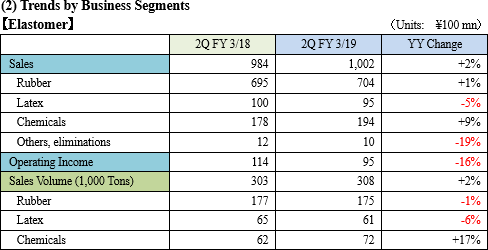 Sales increased, but profit decreased.
Sales were 100.2 billion yen, up 1.8 billion yen year on year. Rubber prices rose, and sales at overseas subsidiaries also grew steadily. Sales of chemicals also increased due to reflecting of the raised costs of raw materials to the price of the products. Meanwhile, both quantities and sales of latex decreased due to a decline in shipment volumes associated with periodic inspections of customers and plants. Sales volume of rubber declined by 1%. Sales volume of general-purpose rubber declined by 2% due to weak export sales. Sales of special-purpose rubber increased by 2% due to healthy domestic sales.
Operating income was 9.5 billion yen, down 1.8 billion yen year on year. Operating income margin declined by 2.1 points from 11.6% in the same period last year to 9.5%.
The increase in quantities of chemicals accounted for an increment of 1 billion yen, and the rise in sales prices made up an increment of 1.4 billion yen. The cost factor attributable to the rise in raw material price was negative 3.3 billion yen and the factor of SG&A expense due to rubber inventory storage fee and freight increase was negative 0.7 billion yen.
Sales increased, but profit decreased.
Sales were 100.2 billion yen, up 1.8 billion yen year on year. Rubber prices rose, and sales at overseas subsidiaries also grew steadily. Sales of chemicals also increased due to reflecting of the raised costs of raw materials to the price of the products. Meanwhile, both quantities and sales of latex decreased due to a decline in shipment volumes associated with periodic inspections of customers and plants. Sales volume of rubber declined by 1%. Sales volume of general-purpose rubber declined by 2% due to weak export sales. Sales of special-purpose rubber increased by 2% due to healthy domestic sales.
Operating income was 9.5 billion yen, down 1.8 billion yen year on year. Operating income margin declined by 2.1 points from 11.6% in the same period last year to 9.5%.
The increase in quantities of chemicals accounted for an increment of 1 billion yen, and the rise in sales prices made up an increment of 1.4 billion yen. The cost factor attributable to the rise in raw material price was negative 3.3 billion yen and the factor of SG&A expense due to rubber inventory storage fee and freight increase was negative 0.7 billion yen.
 Sales decreased but profit increased.
Sales decreased to 42.4 billion yen, down 0.7 billion yen year on year. Specialty chemicals were healthy as chemicals including synthetic fragrances increased by 14% year on year and battery materials increased by 36% year on year. On the other hand, sales of optical films were down 12% year on year due to customer inventory adjustments, but the second half is on a recovery trend. The sales volume of optical films decreased by 3% year on year, and sales ratio of optical films for small- to medium-sized display fell to 23% from 28% in the same period last year.
Operating income was 8.7 billion yen, up 0.6 billion yen year on year. Operating income margin rose 1.6 points from 19.0% in the same period last year to 20.6%.
Price factor of negative 0.6 billion yen and SG&A expense of 400 million yen were offset by the quantity factor of 2 billion yen due to an increase in quantity of chemicals and battery materials.
Sales decreased but profit increased.
Sales decreased to 42.4 billion yen, down 0.7 billion yen year on year. Specialty chemicals were healthy as chemicals including synthetic fragrances increased by 14% year on year and battery materials increased by 36% year on year. On the other hand, sales of optical films were down 12% year on year due to customer inventory adjustments, but the second half is on a recovery trend. The sales volume of optical films decreased by 3% year on year, and sales ratio of optical films for small- to medium-sized display fell to 23% from 28% in the same period last year.
Operating income was 8.7 billion yen, up 0.6 billion yen year on year. Operating income margin rose 1.6 points from 19.0% in the same period last year to 20.6%.
Price factor of negative 0.6 billion yen and SG&A expense of 400 million yen were offset by the quantity factor of 2 billion yen due to an increase in quantity of chemicals and battery materials.
 Sales and profit increased. Operating income margin declined 1.6 points year on year from 6.2% to 4.6%
Sales and profit increased. Operating income margin declined 1.6 points year on year from 6.2% to 4.6%
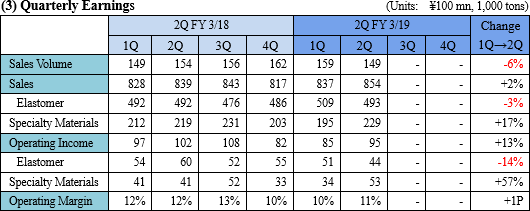 Cumulative sales increased and cumulative profit decreased, but quarterly sales and profit increased. The performance of elastomers and specialty materials was healthy.
Cumulative sales increased and cumulative profit decreased, but quarterly sales and profit increased. The performance of elastomers and specialty materials was healthy.
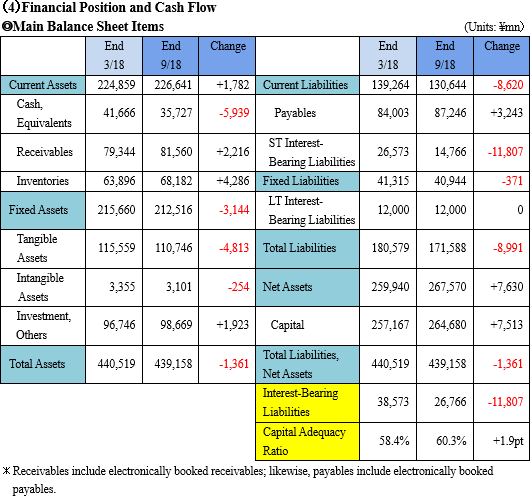 Cash, Equivalents decreased due to bond retirement, but current assets grew 1.7 billion yen from the end of the previous term due to an increase in inventories assets. Total fixed assets decreased 3.1 billion yen from the end of the previous term due to a decrease in tangible assets. Total assets decreased 1.3 billion yen from the end of the previous term.
Total liabilities decreased 8.9 billion yen from the end of the previous term, as interest-bearing debts shrank 11.8 billion yen due to bond retirement.
Net assets grew 7.6 billion yen from the end of the previous term. As a result, capital adequacy ratio grew 1.9 points from the end of the previous term to 60.3%.
Cash, Equivalents decreased due to bond retirement, but current assets grew 1.7 billion yen from the end of the previous term due to an increase in inventories assets. Total fixed assets decreased 3.1 billion yen from the end of the previous term due to a decrease in tangible assets. Total assets decreased 1.3 billion yen from the end of the previous term.
Total liabilities decreased 8.9 billion yen from the end of the previous term, as interest-bearing debts shrank 11.8 billion yen due to bond retirement.
Net assets grew 7.6 billion yen from the end of the previous term. As a result, capital adequacy ratio grew 1.9 points from the end of the previous term to 60.3%.
 The surplus of operating CF and free CF decreased due to an increase in inventory assets. The deficit of financing CF increased due to bond retirement. The cash position improved.
The surplus of operating CF and free CF decreased due to an increase in inventory assets. The deficit of financing CF increased due to bond retirement. The cash position improved.
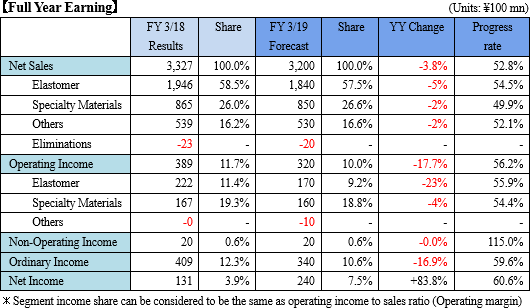
 There is no change in the estimates. Sales and profit are estimated to decrease.
There is no change in the estimates. Sales are estimated to decrease 3.8% year on year to 320 billion yen, while operating income is projected to decline 17.7% to 32 billion yen. Operating margin is estimated to decline 1.7 points to 10.0%. The yen is forecasted to get 10% stronger against the dollar. For both businesses, sales and profit are estimated to decrease.
Since impairment loss was posted in the previous term, net income is projected to rise considerably.
The dividend amount is to be 19.00 yen/share, up 2 yen/share from the previous term. The estimated payout ratio is 17.6%.
There is no change in the estimates. Sales and profit are estimated to decrease.
There is no change in the estimates. Sales are estimated to decrease 3.8% year on year to 320 billion yen, while operating income is projected to decline 17.7% to 32 billion yen. Operating margin is estimated to decline 1.7 points to 10.0%. The yen is forecasted to get 10% stronger against the dollar. For both businesses, sales and profit are estimated to decrease.
Since impairment loss was posted in the previous term, net income is projected to rise considerably.
The dividend amount is to be 19.00 yen/share, up 2 yen/share from the previous term. The estimated payout ratio is 17.6%.
 As for the key development areas, the company applies for "global environment (e.g. energy conservation, automobile-related, power generation and storage)", "health and living (e.g. automatic driving, medical equipment/materials, daily necessities)" and "smart devices (IoT-related)," which are estimated to have a high growth rate and probability of innovation.
As for the key development areas, the company applies for "global environment (e.g. energy conservation, automobile-related, power generation and storage)", "health and living (e.g. automatic driving, medical equipment/materials, daily necessities)" and "smart devices (IoT-related)," which are estimated to have a high growth rate and probability of innovation.
 ① Elastomer Business
◎SSBR:Reinforcement, energy conservation
By combining the polymer modification and production technologies of Zeon and Sumitomo Chemical, the company is committed to providing products that meet Tire customes' requirements such as "good wet grip," "low fuel consumption" and "good abrasion resistance". It is aiming to seize the leading position in the world. The sales volume of SSBR is estimated to increase about 1.5 times between 2017 and 2020.
◎Specialty Rubber: Reinforcement, Automotive
The company established "Zeon Chemicals Asia Co., Ltd.", a new company that manufactures and sells acrylic rubber in Thailand.
Its plant has a production capacity of 5,000 tons/year. It is the company's third site and fourth plant, following Japan and the United States. It will cover the demand expected to expand steadily in the Asian region, led by production growth of internal combustion and turbo charged engine vehicles.
Completion of the construction is scheduled for the spring of 2020.
◎Latex: Reinforcement, Daily necessities
The company will strengthen the production system for high-solids NBR latex for foam rubber.
High-solids NBR latex has good oil resistance, high concentration and low viscosity, and it is suitable for cosmetic puffs. It will meet the needs of the growing cosmetics market.
The sales volume of high concentration NBR latex in the fiscal year 2020 is expected to increase by about 1.3 times from that of the fiscal year 2016.
◎SIS:Reinforcement, Daily necessities
By further promoting asymmetric SIS that has superior strength and elasticity, the company will further expand the domain of SIS, while differentiating products, such as flexography, protective films, adhesive tapes, and hot-melt adhesives, in addition to elastic films and adhesive labels. Recently, the applications are expanding in sanitary fields, for example, for disposable diapers, and large-scale application was decided in the second half of 2018.
The company also started selling SIS for label applications, and the use of SIS for flexography is also ongoing.
The sales volume of asymmetric SIS in the fiscal year 2020 is expected to increase by about 15 times from that of the fiscal year 2017. (It grew six times as of April 2018.)
◎Housing exterior materials: Explore, Daily necessities
One of the company's subsidiaries, Zeon Kasei, launched a new series "GRAYNE®" of "ZEON Siding", which is a resin-based exterior material for houses.
The company imports "GRAYNE®" which has an excellent design with realistic wood grain patterns molded from natural cedar wood and deep color due to hybrid structure. Compared with ceramic materials, it has high durability against frost damage and salt damage. It is also characterized by high impact resistance, which can withstand a golf ball flying at 120 km/h.
Together with conventional siding products, sales of "ZEON Siding" in the fiscal year 2020 are expected to increase by about 1.5 times from that of the fiscal year 2017.
② Specialty Material Business
◎COP Development of new products, IoT-related
The company, which has been working on the development of unconventional plastic that has both heat resistance and low water absorption functions, succeeded in developing a new COP resin. The developed product called "L-24" has characteristics of low water absorption, excellent hydrolysis resistance, low transmission loss, low specific gravity (about 1.0), high heat resistance (melting point: 265 °C), high chemical resistance (insoluble in acid, alkali, and organic solvent), and flex resistance. It is expected to be used for a wide range of purposes such as antennas, nonwoven fabric, cases, cassettes and bottles.
◎ZeonorFilm:Reinforcement, IoT-related
The company will strengthen the production capacity of ZeonorFilm®.
First, the company decided to increase the production capacity of extruded films for optical films in order to respond to the increasing demand for mobile equipment and large-sized TV, which require high definition.
Mass production is expected to start in October 2019 at Optes Inc. Hokuriku Plant (Tsuruga).
Furthermore, in response to the growing demand for ultra-wide and high definition large-sized TVs, the company decided to add production lines for optical films for large-sized TVs at Optes Hokuriku factory, Tsuruga plant.
Its production capacity is 50 million m2 /year, and it produces the widest film in the world. It will start mass production in April 2020.
◎Battery materials: Solution
Along with the increase in capacity of lithium ion batteries and applications in automobiles, the use of separators forming functional layers are rapidly expanding to improve safety. The company is providing materials for the functional layer to the market, and it will further expand the business.
◎Medical devices: Development of new products, medical devices
The company launched balloon catheters for bile duct stone removal in May 2018 and HILZO biliary stents in August. It will further increase sales by launching new products targeting the gastrointestinal system market.
A balloon catheter for bile duct stone removal is a short-wire lumen type catheter, which enables easy change of catheter while leaving the guide wire, and the market share is rapidly expanding. The company is aiming to occupy the second largest share in the domestic market.
HILZO biliary stent features a moving cell structure that makes it easy to expand the cell, and the company aims to expand the market share by selling both stents of this braided type and the laser cut type biliary stents.
Together with the devices for the cardiovascular system, the company will achieve steady growth.
◎DCP-RIM:Reinforcement, energy-consumption
DCP-RIM is a plastic resin featuring low viscosity, impact resistance, heat resistance, and chemical resistance. DCP-RIM makes it possible to achieve "large integral molding with high physical property balance to withstand use without metal/ glass reinforcement", "design that responds to the market needs with consideration of unique and diverse design and aerodynamic characteristics", and "weight reduction by replacement from metals and FRP parts for low fuel consumption and overload restriction measures". It is anticipated that DCP-RIM will be used for large trucks and buses. The company expects that the sales volume of DCP-RIM for trucks and buses in 2020 will increase by 3.6 times from that of 2016.
◎High thermal conductivity heat release sheet: New business creation, IoT-related
The company has developed a high-performance pad-type thermal interface material (TIM) with high thermal conductivity in the vertical direction, and it is expecting that this material will solve thermal problems of servers and power devices.
◎Carbon nanotubes (CNT): Accelerate new business creation and product development
(Launch "SGOINT®O-ring" with excellent high-temperature/high-pressure resistance functions and cost effectiveness)
In February 2017, the company, National Institute of Advanced Industrial Science and Technology (AIST), which is a National R&D Agency, and Sunarrow Ltd. jointly established "Zeon Sunarrow AIST CNT Composite Material Research Center", and have been proceeding with the research on CNT composites. As the result of that, most recently, they launched "SGOINT®O-ring" with excellent in high-temperature/high-pressure resistance functions and cost effectiveness.
SGOINT®O-ring is produced by combining the company's carbon nanotube "ZEONANO® SG101" and ternary PO crosslinking fluro-rubber. It overcomes the permanent compression set which had been a problem of CNT compound, and it is possible to provide high performance O-rings at reasonable prices.
Rubber O-rings used as sealing materials for piping and containers are characterized by high sealability and flexibility. However, in harsh environments with high temperature and high pressure, for example, when they are used at chemical plants, for power generation or for oil drilling, there was a limit on the lifespan, etc. As a result, there were problems such as limited application range and frequent replacement. In addition, from the viewpoint of energy saving, there was demand for replacing metal seal materials for automobiles and aircraft with lightweight materials.
In response to these challenges, SGOINT®O-ring is expected to be used as sealing materials for oil drilling equipment and as replacement of metal seals for engine peripheral parts of automobiles and aircraft, thus contributing to less frequent replacement and smaller management costs.
(Project LNES)
The company is working on LNES, a project to create a new lifestyle by offering new energies and environments that lead to the next connected society. (LNES stands for Leading, Next, Engaging, Society or Leading, New, Energy/ Environment, Solution)
The project is intending to realize nano-carbon hybrid solar cells by new printing technologies and propose a new life style and culture where people generate and use small amount of energy by themselves.
① Elastomer Business
◎SSBR:Reinforcement, energy conservation
By combining the polymer modification and production technologies of Zeon and Sumitomo Chemical, the company is committed to providing products that meet Tire customes' requirements such as "good wet grip," "low fuel consumption" and "good abrasion resistance". It is aiming to seize the leading position in the world. The sales volume of SSBR is estimated to increase about 1.5 times between 2017 and 2020.
◎Specialty Rubber: Reinforcement, Automotive
The company established "Zeon Chemicals Asia Co., Ltd.", a new company that manufactures and sells acrylic rubber in Thailand.
Its plant has a production capacity of 5,000 tons/year. It is the company's third site and fourth plant, following Japan and the United States. It will cover the demand expected to expand steadily in the Asian region, led by production growth of internal combustion and turbo charged engine vehicles.
Completion of the construction is scheduled for the spring of 2020.
◎Latex: Reinforcement, Daily necessities
The company will strengthen the production system for high-solids NBR latex for foam rubber.
High-solids NBR latex has good oil resistance, high concentration and low viscosity, and it is suitable for cosmetic puffs. It will meet the needs of the growing cosmetics market.
The sales volume of high concentration NBR latex in the fiscal year 2020 is expected to increase by about 1.3 times from that of the fiscal year 2016.
◎SIS:Reinforcement, Daily necessities
By further promoting asymmetric SIS that has superior strength and elasticity, the company will further expand the domain of SIS, while differentiating products, such as flexography, protective films, adhesive tapes, and hot-melt adhesives, in addition to elastic films and adhesive labels. Recently, the applications are expanding in sanitary fields, for example, for disposable diapers, and large-scale application was decided in the second half of 2018.
The company also started selling SIS for label applications, and the use of SIS for flexography is also ongoing.
The sales volume of asymmetric SIS in the fiscal year 2020 is expected to increase by about 15 times from that of the fiscal year 2017. (It grew six times as of April 2018.)
◎Housing exterior materials: Explore, Daily necessities
One of the company's subsidiaries, Zeon Kasei, launched a new series "GRAYNE®" of "ZEON Siding", which is a resin-based exterior material for houses.
The company imports "GRAYNE®" which has an excellent design with realistic wood grain patterns molded from natural cedar wood and deep color due to hybrid structure. Compared with ceramic materials, it has high durability against frost damage and salt damage. It is also characterized by high impact resistance, which can withstand a golf ball flying at 120 km/h.
Together with conventional siding products, sales of "ZEON Siding" in the fiscal year 2020 are expected to increase by about 1.5 times from that of the fiscal year 2017.
② Specialty Material Business
◎COP Development of new products, IoT-related
The company, which has been working on the development of unconventional plastic that has both heat resistance and low water absorption functions, succeeded in developing a new COP resin. The developed product called "L-24" has characteristics of low water absorption, excellent hydrolysis resistance, low transmission loss, low specific gravity (about 1.0), high heat resistance (melting point: 265 °C), high chemical resistance (insoluble in acid, alkali, and organic solvent), and flex resistance. It is expected to be used for a wide range of purposes such as antennas, nonwoven fabric, cases, cassettes and bottles.
◎ZeonorFilm:Reinforcement, IoT-related
The company will strengthen the production capacity of ZeonorFilm®.
First, the company decided to increase the production capacity of extruded films for optical films in order to respond to the increasing demand for mobile equipment and large-sized TV, which require high definition.
Mass production is expected to start in October 2019 at Optes Inc. Hokuriku Plant (Tsuruga).
Furthermore, in response to the growing demand for ultra-wide and high definition large-sized TVs, the company decided to add production lines for optical films for large-sized TVs at Optes Hokuriku factory, Tsuruga plant.
Its production capacity is 50 million m2 /year, and it produces the widest film in the world. It will start mass production in April 2020.
◎Battery materials: Solution
Along with the increase in capacity of lithium ion batteries and applications in automobiles, the use of separators forming functional layers are rapidly expanding to improve safety. The company is providing materials for the functional layer to the market, and it will further expand the business.
◎Medical devices: Development of new products, medical devices
The company launched balloon catheters for bile duct stone removal in May 2018 and HILZO biliary stents in August. It will further increase sales by launching new products targeting the gastrointestinal system market.
A balloon catheter for bile duct stone removal is a short-wire lumen type catheter, which enables easy change of catheter while leaving the guide wire, and the market share is rapidly expanding. The company is aiming to occupy the second largest share in the domestic market.
HILZO biliary stent features a moving cell structure that makes it easy to expand the cell, and the company aims to expand the market share by selling both stents of this braided type and the laser cut type biliary stents.
Together with the devices for the cardiovascular system, the company will achieve steady growth.
◎DCP-RIM:Reinforcement, energy-consumption
DCP-RIM is a plastic resin featuring low viscosity, impact resistance, heat resistance, and chemical resistance. DCP-RIM makes it possible to achieve "large integral molding with high physical property balance to withstand use without metal/ glass reinforcement", "design that responds to the market needs with consideration of unique and diverse design and aerodynamic characteristics", and "weight reduction by replacement from metals and FRP parts for low fuel consumption and overload restriction measures". It is anticipated that DCP-RIM will be used for large trucks and buses. The company expects that the sales volume of DCP-RIM for trucks and buses in 2020 will increase by 3.6 times from that of 2016.
◎High thermal conductivity heat release sheet: New business creation, IoT-related
The company has developed a high-performance pad-type thermal interface material (TIM) with high thermal conductivity in the vertical direction, and it is expecting that this material will solve thermal problems of servers and power devices.
◎Carbon nanotubes (CNT): Accelerate new business creation and product development
(Launch "SGOINT®O-ring" with excellent high-temperature/high-pressure resistance functions and cost effectiveness)
In February 2017, the company, National Institute of Advanced Industrial Science and Technology (AIST), which is a National R&D Agency, and Sunarrow Ltd. jointly established "Zeon Sunarrow AIST CNT Composite Material Research Center", and have been proceeding with the research on CNT composites. As the result of that, most recently, they launched "SGOINT®O-ring" with excellent in high-temperature/high-pressure resistance functions and cost effectiveness.
SGOINT®O-ring is produced by combining the company's carbon nanotube "ZEONANO® SG101" and ternary PO crosslinking fluro-rubber. It overcomes the permanent compression set which had been a problem of CNT compound, and it is possible to provide high performance O-rings at reasonable prices.
Rubber O-rings used as sealing materials for piping and containers are characterized by high sealability and flexibility. However, in harsh environments with high temperature and high pressure, for example, when they are used at chemical plants, for power generation or for oil drilling, there was a limit on the lifespan, etc. As a result, there were problems such as limited application range and frequent replacement. In addition, from the viewpoint of energy saving, there was demand for replacing metal seal materials for automobiles and aircraft with lightweight materials.
In response to these challenges, SGOINT®O-ring is expected to be used as sealing materials for oil drilling equipment and as replacement of metal seals for engine peripheral parts of automobiles and aircraft, thus contributing to less frequent replacement and smaller management costs.
(Project LNES)
The company is working on LNES, a project to create a new lifestyle by offering new energies and environments that lead to the next connected society. (LNES stands for Leading, Next, Engaging, Society or Leading, New, Energy/ Environment, Solution)
The project is intending to realize nano-carbon hybrid solar cells by new printing technologies and propose a new life style and culture where people generate and use small amount of energy by themselves.
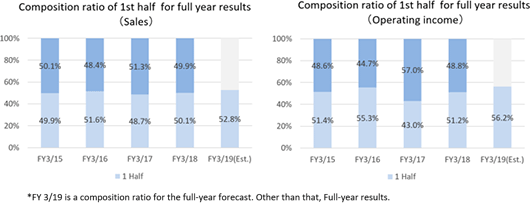
 ◎ Corporate Governance Report
The company submitted a latest corporate governance report on June, 4, 2018
<Basic policy>
Our company respects the interests of a broad range of stakeholders, including shareholders, and aims to earn revenue and continuously improve our corporate value while adjusting the relations of interests. To do so, we will make continuous efforts to establish a system for realizing efficient, sound business administration through corporate governance.
In addition, we will make decisions and execute business operations swiftly after clarifying the functions and roles of each institution and each in-company organization by developing internal control systems. We will properly monitor and disclose its progress and results and strive to improve the transparency of our business administration.
<Reasons for Non-compliance with the Principles of the Corporate Governance Code (Excerpts)>
(All principles are stated based on the code before the revision in June 2018.)
At the 93rd annual meeting of shareholders, we started disclosing the convocation notice for each general meeting of shareholders in our website before dispatching it (Supplementary Principle 1-2-2). Therefore, our company follows the principles of the corporate governance code.
◎ Corporate Governance Report
The company submitted a latest corporate governance report on June, 4, 2018
<Basic policy>
Our company respects the interests of a broad range of stakeholders, including shareholders, and aims to earn revenue and continuously improve our corporate value while adjusting the relations of interests. To do so, we will make continuous efforts to establish a system for realizing efficient, sound business administration through corporate governance.
In addition, we will make decisions and execute business operations swiftly after clarifying the functions and roles of each institution and each in-company organization by developing internal control systems. We will properly monitor and disclose its progress and results and strive to improve the transparency of our business administration.
<Reasons for Non-compliance with the Principles of the Corporate Governance Code (Excerpts)>
(All principles are stated based on the code before the revision in June 2018.)
At the 93rd annual meeting of shareholders, we started disclosing the convocation notice for each general meeting of shareholders in our website before dispatching it (Supplementary Principle 1-2-2). Therefore, our company follows the principles of the corporate governance code.
